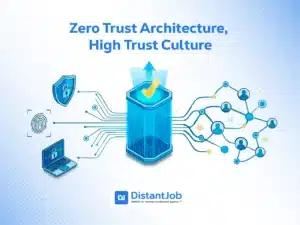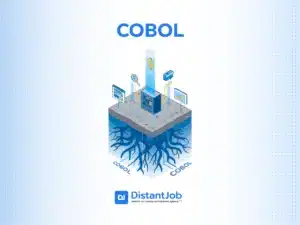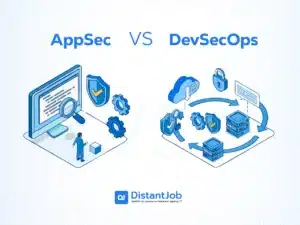When hiring a new IT manager, you want to give him every advantage possible to perform quickly and efficiently. This is why a 30-60-90 day plan template is so important. This document will describe the goals that you expect your new manager to reach during his/her first 3 months of work.
A good plan sets expectations, short-term goals, and long-term goals, and identifies other individuals your new employee should connect with for guidance and support.
We will show you how to create a 30-60-90 day plan to ensure that your new manager will be successful in your company. But first, we should explain what a 30-60-90 day plan actually is.
What is a 30-60-90-Day Plan?
A 30-60-90 day plan strategy for a manager is different than a plan for average employees because of the manager’s role in the organization and the importance of the manager’s strategic priorities and employee development.
For example, a typical employee might emphasize learning a process, while a manager focuses on building relationships with critical people.
The plan also aligns employees with company expectations, which helps create a smoother onboarding process and sets the stage for long-term success. By clearly identifying what new employees should accomplish every 30 days, both the employees and their managers know what should happen next.
4 Effective Steps to Write a 30-60-90-Day Plan
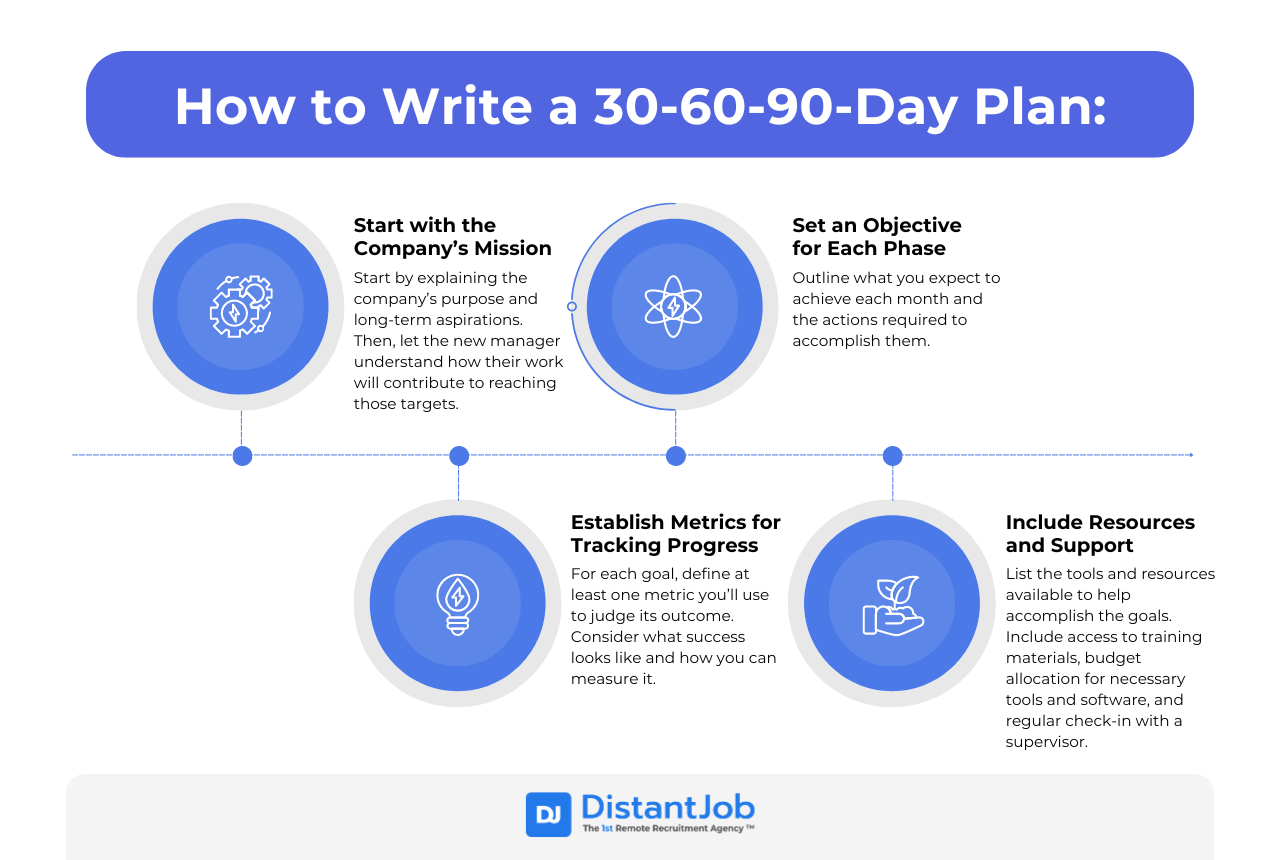
A 30 60 90 day plan strategy for a manager will have distinct nuances from a plan created for regular employees. This difference stems from the manager’s level of responsibility within the organization and their focus on strategic priorities and team development.
For instance, while a typical team member’s plan might include specific goals related to learning company processes, a manager’s plan will prioritize building solid relationships with key stakeholders.
Here’s how to craft an effective leadership transition plan for an IT manager:
1. Start with the Company’s Mission
Begin by clearly outlining the company’s purpose and long-term aspirations. This step plays a crucial role in a successful new manager transition plan. It ensures the new manager understands how their work aligns and contributes to these goals, fostering a sense of purpose and belonging, which are key drivers of job satisfaction and retention. For more insights into effective management practices, especially in IT, you might want to explore our article on IT Management.
Moreover, research reveals that understanding a company’s vision can improve productivity and employee engagement. A Deloitte study found that 94% of executives and 88% of employees agree that a distinct company culture is crucial for business success.
An organization’s vision shapes its culture, providing employees with a clear direction and motivation to work towards shared objectives.
2. Set an Objective for Each Phase
This is the heart of the first 90 days plan. Clearly define what you expect the new hire to achieve each month and outline the actions required to accomplish these objectives.
For a new IT manager, the objectives for the first 30 days could be understanding the company, assessing current systems and processes, and building relationships. From days 31-60, the expectations may progress to deepening knowledge and assessment, strategic planning, and process implementation. In the last 30 days (61-90), the goals may include optimizing performance, strengthening communication, and building a sustainable IT culture. If your new hire will be working remotely, reviewing our Remote Onboarding Checklist can help ensure a smooth and effective transition.
A good rule of thumb for the goal-setting phase is to limit the goals between three and five for clarity and focus. Additionally, set SMART (specific, measurable, achievable, realistic, and timely) goals. This approach ensures that the new manager remains focused, significantly improving the likelihood of achieving the set goals.
For example, instead of the vague goal of “building a sustainable IT culture,” a SMART goal would be “increasing team member engagement in IT projects by 20% within the next three months.”
3. Establish Metrics for Tracking Progress
For each goal, identify at least one metric that will be used to evaluate its outcome. Determine clear success criteria and establish how to measure progress effectively. For example, if the goal is to build a sustainable IT culture, a key metric could be the percentage of employees actively participating in IT training and workshops. For remote teams, understanding the broader remote onboarding process can also help in setting relevant and achievable metrics.
4. Include Resources and Support
It’s vital to list the tools and resources available to help the new manager accomplish their goals as part of the management onboarding plan. These resources might include access to training materials, budget allocation for necessary tools and software, and regular check-ins with a supervisor. If your IT manager will be working remotely or managing a remote team, you might find our article on Best Remote Team Tools & Task Management helpful. Additionally, understanding the challenges and best practices of Remote Management can further support their success.
A supportive environment increases the manager’s chances of success and fosters a positive company culture.
30-60-90-day Plan Template
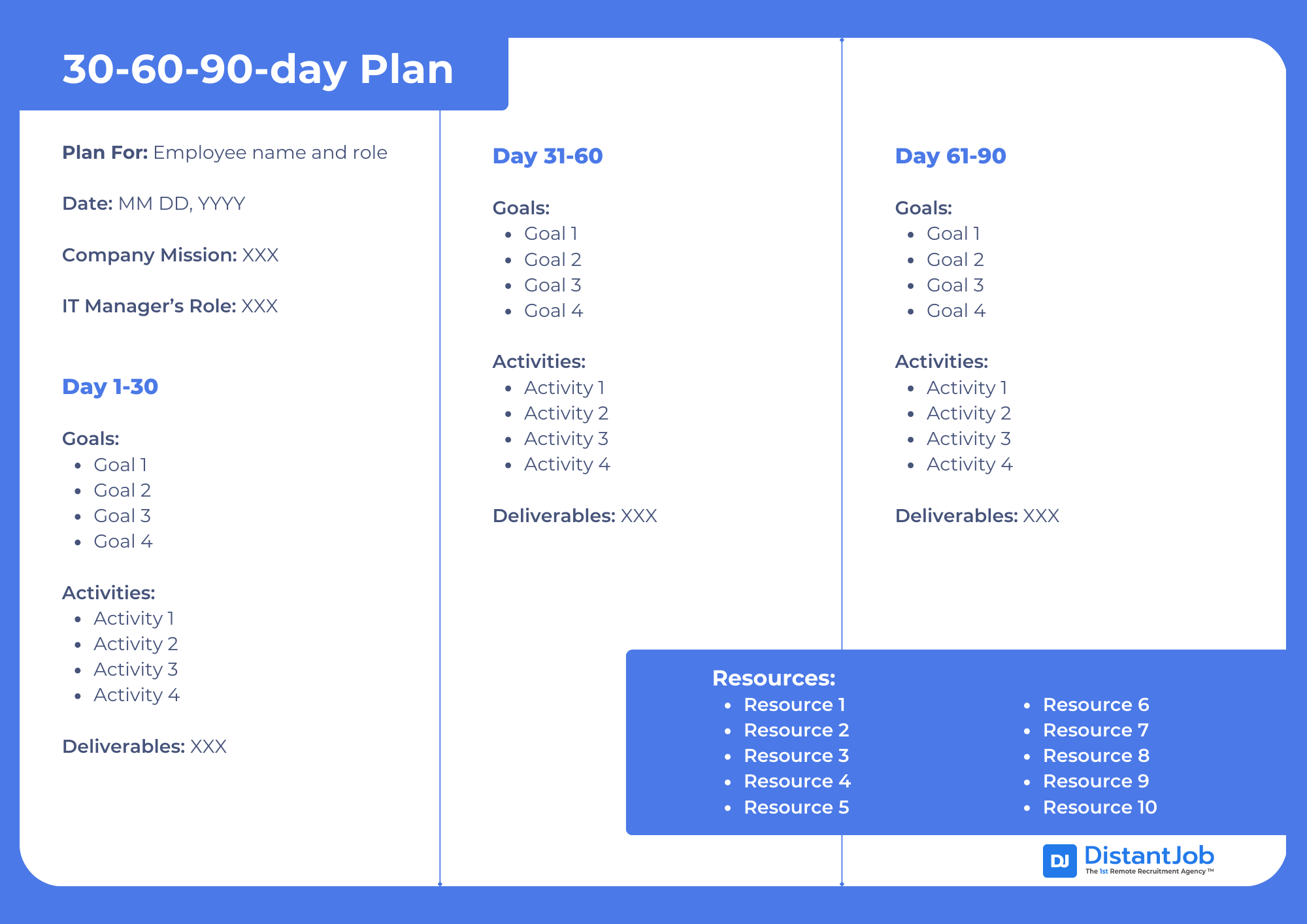
Customize your own 30-60-90-day plan with our free Canva template here.
Below is an example of this plan for an IT manager:
30-60-90-Day Plan Example for IT Manager
Plan For: Elizabeth Myers — IT Manager
Date: August 1, 2024
Company Mission: To help entrepreneurs and small business owners organize their work more efficiently by providing innovative IT solutions tailored to their needs and budgets.
IT Manager’s Role: The IT manager oversees the company’s IT infrastructure, manages a team of IT professionals, and ensures the smooth operation of all technological systems.
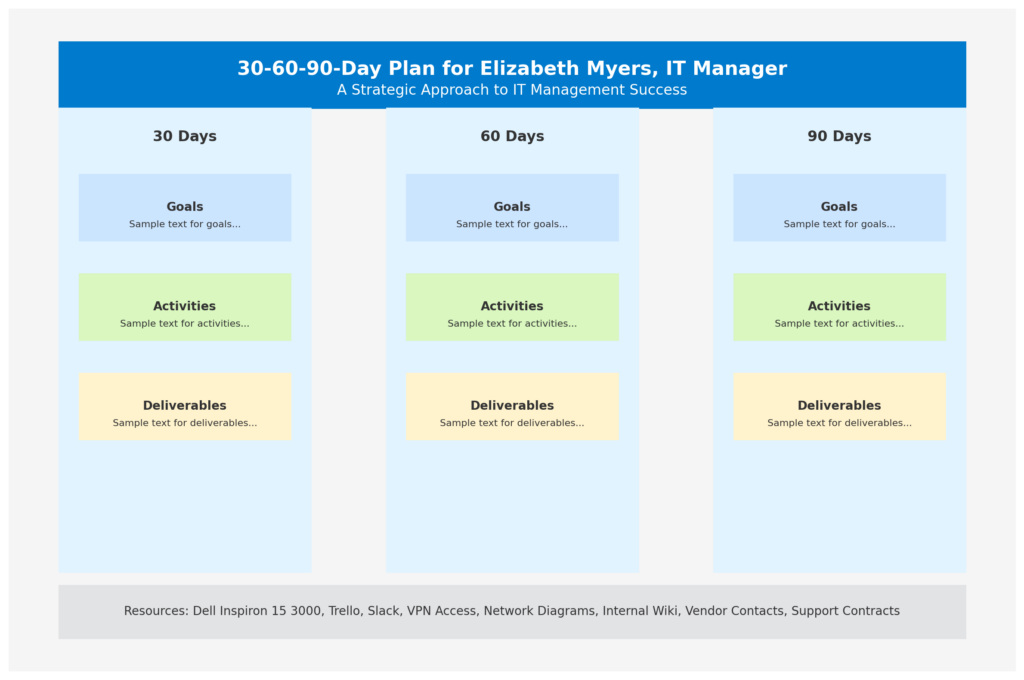
The First 30 Days: Learning and Observing
Week 1:
Goal: Meet with key stakeholders, understand business objectives, and assess the current IT environment.
Activities:
- Meet with CEO, COO, and other C-level executives to understand business priorities and IT expectations.
- Meet with direct reports and team members to understand roles, responsibilities, and team dynamics.
- Conduct a preliminary assessment of IT infrastructure, systems, and applications.
- Review IT budget, staffing, and resource allocation.
Deliverables:
- Initial assessment of IT environment and team capabilities.
- Communication plan for team members.
Week 2:
Goal: Deep dive into IT operations and identify key areas for improvement.
Activities:
- Review IT policies, procedures, and standards.
- Assess IT service delivery and customer satisfaction.
- Identify potential IT risks and vulnerabilities.
- Meet with key vendors and partners.
Deliverables:
- Gap analysis of IT capabilities vs. business needs.
- Initial list of potential IT projects.
Week 3:
Goal: Build relationships with key stakeholders and understand business processes.
Activities:
- Meet with department heads to understand their IT needs and challenges.
- Attend relevant business meetings to gain insights into operations.
- Conduct a SWOT analysis of the IT department.
Deliverables:
- Stakeholder relationship map.
- SWOT analysis report.
Week 4:
Goal: Identify quick wins and immediate improvements
Activities:
- Prioritize issues identified in the assessment
- Implement minor, high-impact improvements
- Begin developing team performance metrics
Deliverable:
- 30-day progress report and quick wins implementation plan
The Next 30 Days (60 Days Total): Planning and Strategizing
Week 5:
Goal: Develop a comprehensive IT strategy
Activities:
- Finalize IT strategy document
- Create action plans for major initiatives
- Begin risk assessment and mitigation planning
Deliverable:
- Comprehensive IT strategy document
Week 6:
Goal: Improve team performance and processes
Activities:
- Implement new team performance metrics
- Review and optimize IT processes and workflows
- Conduct skills gap analysis
Deliverable:
- Updated team structure and process documentation
Week 7:
Goal: Enhance security and compliance
Activities:
- Review current security policies and procedures
- Conduct security audit
- Develop or update the disaster recovery plan
Deliverable:
- Security audit report
Week 8:
Goal: Initiate strategic projects
Activities:
- Launch high-priority projects identified in the IT strategy
- Establish project management methodologies
- Set up reporting and monitoring mechanisms for projects
Deliverable:
- Project charters for strategic initiatives and 60-day progress report
The Final 30 Days (90 Days Total): Executing and Optimizing
Week 9:
Goal: Optimize IT infrastructure
Activities:
- Assess current hardware and software inventory
- Develop plans for upgrades or migrations
- Explore cloud adoption opportunities
Deliverable:
- Infrastructure optimization plan
Week 10:
Goal: Enhance user support and satisfaction
Activities:
- Review help desk performance and user feedback
- Implement improvements to the ticketing system
- Conduct a user satisfaction survey
Deliverable:
- User support improvement plan and survey results
Week 11:
Goal: Foster innovation and emerging technologies
Activities:
- Research industry trends and emerging technologies
- Develop innovation initiatives
- Identify potential pilot projects for new technologies
Deliverable:
- Innovation roadmap and pilot project proposals
Week 12-13:
Goal: Review and refine overall progress
Activities:
- Assess progress on all initiatives and projects
- Gather feedback from the team and stakeholders
- Adjust strategies and plans as needed
- Prepare a comprehensive 90-day report
Deliverable:
- 90-day comprehensive report and refined IT strategy
Resources:
- DELL Inspiron 15 3000 Laptop
- Trello
- Slack
- VPN Access
- Network diagrams
- Admin credentials
- Internal Wiki
- IT policy, security protocols, and operational procedures
- Onboarding materials
- Vendor contacts
- Service Level Agreements
- Support contracts’
- Maintenance schedules
Conclusion
A 30-60-90 day plan is an essential tool to help guide your IT manager during the ramp-up period. The plan sets your new employee up for success by providing clarity on expectations and what he/she should accomplish.
Still, a plan is only as effective as the person who executes it. That is why the real key to success is hiring the right IT manager.
This is where we come in. At DistantJob, we specialize in remote IT recruitment, connecting you with top-tier IT professionals who are highly skilled and a perfect fit for your unique business needs. Our experienced recruiters will work closely with you to understand your specific necessities and find the perfect IT manager for your team. Contact us today to get started.


